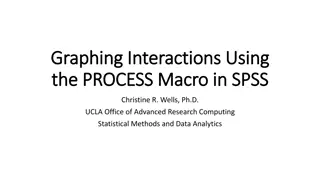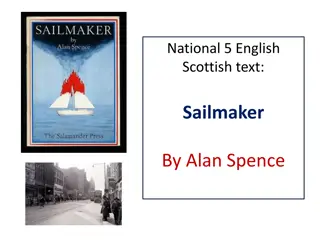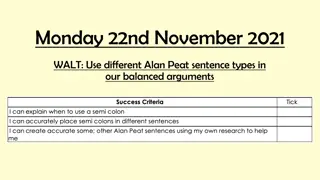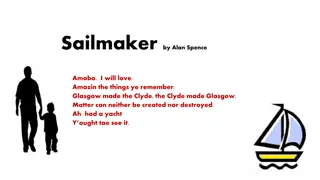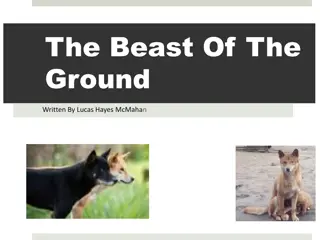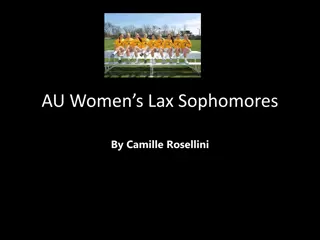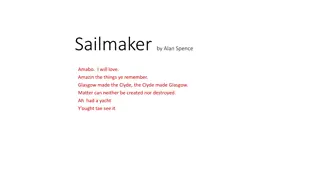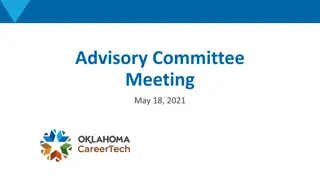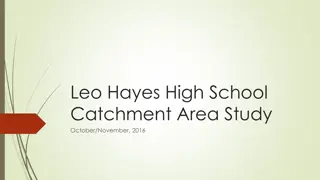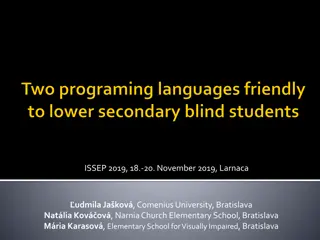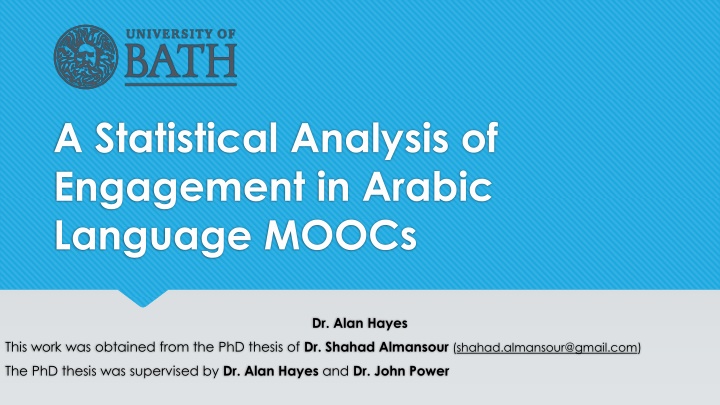
Statistical Analysis of Engagement in Arabic and English MOOCs
Explore the engagement patterns of learners in Arabic and English MOOCs through a statistical analysis. Discover the challenges and objectives of Arabic MOOCs compared to English platforms like Coursera and Futurelearn. Gain insights into learner behaviors such as sampling, disengaging, auditing, and completing in both languages.
Download Presentation

Please find below an Image/Link to download the presentation.
The content on the website is provided AS IS for your information and personal use only. It may not be sold, licensed, or shared on other websites without obtaining consent from the author. If you encounter any issues during the download, it is possible that the publisher has removed the file from their server.
You are allowed to download the files provided on this website for personal or commercial use, subject to the condition that they are used lawfully. All files are the property of their respective owners.
The content on the website is provided AS IS for your information and personal use only. It may not be sold, licensed, or shared on other websites without obtaining consent from the author.
E N D
Presentation Transcript
A Statistical Analysis of Engagement in Arabic Language MOOCs Dr. Alan Hayes This work was obtained from the PhD thesis of Dr. Shahad Almansour (shahad.almansour@gmail.com) The PhD thesis was supervised by Dr. Alan Hayes and Dr. John Power
Introduction In 2013, MOOCs reached the Arabic region with the launch of two Arabic-language platforms, Edraak and Rwaq (Mutawa, 2017). Our objective: improve the understanding of Arabic learners use of MOOCs. Mutawa, A.M., 2017. It is time to MOOC and SPOC in the Gulf Region. Education and Information Technologies, 22(4), pp.1651-1671.
Arabic MOOCs Number of MOOCs 300 110 153 114 294 139 45 Platform Founded Daily visitors* Topics Rwaq.org Edraak.org Nadrus.com Doroob.sa Maharah.net Zadi.net Aanaab.com 2013 2013 2014 2014 2015 2015 2016 34,844 37,579 354 695 N/A 3205 893 Multidisciplinary Multidisciplinary Multidisciplinary Multidisciplinary Multidisciplinary Islamic and Sharia law Education N/A = Data not available *From CuteStat.com
Project challenges Limited published literature on Arabic MOOCs Limited data available from Arabic platforms
English MOOCs (Kizilcec et al. ,2013) (Ferguson and Clow, 2015) Platform Coursera Futurelearn 1. Physical Science for beginner level 2. Life Science for beginner level 3. Art for beginner level 4. Business for beginner level 1. Computer Science for high school level 2. Computer Science for undergraduate level 3. Computer Science for graduate level MOOCs Clustering method K-means clustering K-means clustering Watching video lectures Solve assessments Engagement in discussion forum Clustering variables Watching video lectures Solve assessments Kizilcec, R.F., Piech, C. and Schneider, E., 2013, April. Deconstructing disengagement: analyzing learner subpopulations in massive open online courses. In Proceedings of the third international conference on learning analytics and knowledge (pp. 170-179). Ferguson, R. and Clow, D., 2015, March. Examining engagement: analysing learner subpopulations in massive open online courses (MOOCs). In Proceedings of the fifth international conference on learning analytics and knowledge(pp. 51-58).
English MOOCs (Kizilcec et al. ,2013) (Ferguson and Clow, 2015) Results 1. Sampling: Learners watched only one or two video lectures at the beginning of the course before dropping out. 2. Disengaging: Learners completed the assessments at the beginning, then gradually dropped out. 3. Auditing: Learners engaged with the course only by watching video lectures and did not do the assessments. 4. Completing: Learners engaged fully by watching most of the video lectures and completing the assessments. 1. Samplers: Few completed one assignment. 2. Strong Starters: engaged strongly with the course at the beginning, then dropped out. 3. Returners: completed the first assignment then returned to complete the second assignment before dropping out. 4. Midway Dropouts: completed three to four assignments before dropping out. 5. Nearly There: completed most assignments, then dropped out before the end of the course. 6. Late Completers: completed the last assignment. However, some assignments were submitted late and some were missed. 7. Keen Completers: completed all assignments on time.
Research Questions Who are the users of the Arabic MOOC platforms? What are the engagement types of the Arabic-speaking learners? How is the engagement of Arabic-speaking learners in a MOOC similar to or different from the engagement of English-speaking learners in a MOOC?
Methodology Obtain data from an Arabic MOOC Perform K-means clustering algorithm to identify the engagement types of Arabic- speaking learners Compare the engagement types of Arabic- and English- speaking learners to identify similarities and differences.
Edraak MOOC Title: Java Programming 1 Presented by: the Arab Open University, in Jordan Duration: 5 weeks Assessment: 1 per week
Edraak learners Males have a higher enrolment rate than females. Bachelor s degree holders followed by high-school degree holders represent the majority of learners. The majority of Edraak learners come from countries with Medium HDI level. Poor use of the discussion forum.
Arabic learners Engagement types Sampling: learners who had no interaction with the MOOC contents or dropped out from the MOOC after the first week.
Arabic learners Engagement types Disengaging: learners who had a good interaction with the MOOC contents at the first week of the MOOC, and gradually dropped out by the middle of the course.
Arabic learners Engagement types Completing: learners who had a good interaction with the MOOC contents, especially the weekly assessments, throughout the MOOC duration.
Similarities and differences Futurelearn VS Edraak Proportion of Completers in Futurelearn is significantly higher than Edraak. Proportions of Samplers and Mid-way Dropouts in Futurelearn is significantly lower than Edraak.
Similarities and differences Coursera VS Edraak Coursera s HS MOOC had significantly higher proportion of Completing and Disengaging, and significantly lower proportion of Sampling than Edraak s Java MOOC. Coursera s UG and GS MOOCs had similar proportions of engagement with Edraak s Java MOOC.
Similarities and differences Coursera VS Edraak Gender proportion in both the overall enrolment and within each engagement type. Similarities Poor use of the discussion forum. Edraak s learners are mostly from countries with a medium HDI level Coursera s learners are mostly from countries with a very high HDI level Differences Edraak has more Completing learners from countries with high, medium and low HDI levels. Coursera has more Completing learners from countries with very high HDI level.
Conclusion Arabic MOOC platforms provide discussion forums; however, they are rarely used for sharing or exchanging knowledge with the educational community. Arabic MOOC platforms are designed as traditional classrooms in an online platform where the teacher provides the knowledge and learners are expected to study it and apply it to the weekly assessment to pass the MOOC. No clear pedagogical approach adopted by the Arabic MOOC platform.
Future work Obtaining more data and creating a complex classification method for an Arabic MOOC platform Examining the effect of adopting a pedagogical approach on the engagement of Arabic learners. Using the result from our initial result to design further analysis (e.g. questionnaire, interview)
Acknowledgments All thanks to Edraak research team for their cooperation in this research.



